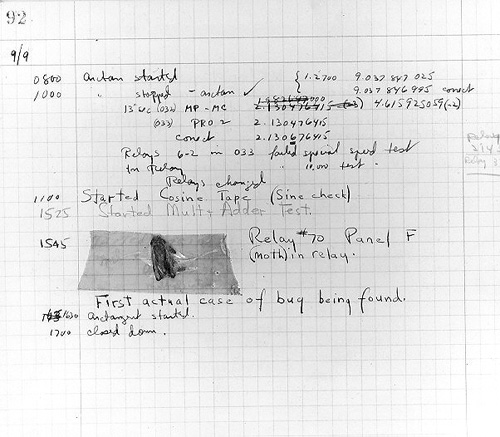myoldmac.net
- Computing F.A.Q.
The first Computer Bug...
9 September 1945 : The "Bug" is
Born
The First Computer Bug...
In 1945, Grace Murray Hopper was working on
the Harvard University Mark II Aiken Relay Calculator. On the 9th of September, 1945, when the machine
was experiencing problems, an investigation showed
that there was a moth trapped between the points
of Relay #70, in Panel F. The operators removed
the moth and affixed it to the log. (See the
picture above.) The entry reads: "First
actual case of bug being found."
Grace Murray Hopper, who lived from 1906-1992,
found the first computer bug while working in
a temporary World War I building at Harvard University
on the Mark II computer where a moth had been
beaten to death in the jaws of a relay. She glued
it into the logbook of the computer and thereafter
when the machine stops (frequently) they say
that they are "debugging" the computer.
The very first bug still exists in the National
Museum of American History of the Smithsonian
Institution. The word bug and the concept of
debugging had been used previously, perhaps by
Edison, but this was probably the first verification
that the concept applied to computers.

Moth found trapped between points at Relay #
70, Panel F, of the Mark II Aiken Relay Calculator
while it was being tested at Harvard University,
9 September 1945. First actual case of bug beeing
found. Copyright: Smithsonian - National Museum of American History
Rear Admiral Grace Murray Hopper, USNR, (1906-1992)
Grace
Murray (Hopper) was born in New York
City on 9 December 1906. She graduated
from Vassar College in 1928 and received
a PhD in Mathematics from Yale University
in 1934. She was a member of the Vassar
faculty from 1931 to 1943, when she joined
the Naval Reserve.
Commissioned a Lieutenant
(Junior Grade) 1944, she was assigned
to the Bureau of Ordnance and immediately
became involved in the development of
the then-embryonic electronic computer.
Over more than four decades to follow,
she was in the forefront of computer
and programming language progress. |
|
During her work with Mark II, Hopper was credited
with coining the term "bug" in reference
to a glitch in the machinery. This story is apparently
a bit of computer folk-lore, however, as the
term had already been used by Harvard personnel
for several years to describe problems with their
computers. It is the case that she and her team
of programmers did find a moth which flew through
an open window and into one of Mark II's relays,
temporarily shutting down the system. The moth
was removed and pasted into a logbook [Photo
of that bug]. At that time the use of the word "bug"
referred to problems with the hardware. In the
mid 1950's, Hopper extended the meaning of the
term "debug" to include removing programming
errors.
The Term
So, where did the term "bug" come
from?
Well, the entry ("First actual case of
bug being found.") shows that the term was
already in use before the moth was discovered.
Grace Hopper also reported that the term "bug" was
used to describe problems in radar electronics
during WWII.
The term was use during Thomas Edison's life
to mean an industrial defect. And in Hawkin's
New Catechism of Electricity, an 1896 electrical
handbook from Theo. Audel & Co.) included
the entry:
The term "bug" is used to a limited
extent to designate any fault or trouble in the
connections or working of electric apparatus.
In discussing the origin of the term, the book
notes that the term is said to have originated
in quadruplex telegraphy and have been transferred
to all electric apparatus. Common folk etymology
says that the phrase "bugs in a telephone
cable" was used to account for noisy lines.
There is no support for this derivation.
Remember this quote:
"Where a calculator on the ENIAC
is equipped with 18,000 vacuum tubes and
weighs 30 tons, computers in the future
may have only 1,000 vacuum tubes and perhaps
weigh 1 1/2 tons."
Popular Mechanics, March 1949.
|
![]()